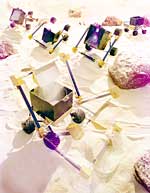Engineers have developed a bulldozer robot that should operate on neighboring planets

Engineers from NASA have presented a prototype of a small robot, which in the future will be able to help explore the surface of the neighboring planets. The robot looks like a cross between a bulldozer and a dirt truck. Its weight does not exceed 4.6 kilograms, it should operate without a driver and be able to overcome obstacles in its path. It is solar powered.
The robot is equipped with an arm with a small scoop, which it uses to pile dirt and empty it into a container. The arm also helps him to re-stabilize himself, if he falls over.
The developers of the robot say that the development is now in the initial stages. But, according to them, after its development is completed, it will be possible to send some robots to the neighboring planets, to dig into their surface, and discover new data about their composition.
The robot is designed so that it can work in a group with other identical robots. Communication between the robots will take place through a central control tower, which will also be placed on the planet. The control tower will be equipped with 360D cameras, which will provide a XNUMX-degree view of the surface. A reflective panel will be placed in the tower, deflecting the sun's energy towards the robot-bulldozers below.
So far, the construction of four models of robots of this type has been completed. Now the engineers are trying to determine what the optimal dimensions are that will fit the various digging tasks that the robots are supposed to perform.
"Small bulldozers have an advantage over big bulldozers," said Brian Wilcox, supervisor of the Robotic Vehicle Research Group at NASA's Jet Propulsion Laboratory, which is developing the robots. "We think it is possible to excavate a larger area when the workload is divided between several relatively small vehicles," Wilcox noted, in an official announcement published by the laboratory. "These all-terrain vehicles may support future missions that will search for life or assist astronauts in their missions," Wilcox said.
The same group of scientists that developed these robotic bulldozers also developed the small off-road vehicle "Sojourner", which was launched to Mars about four years ago on the "Mars Pathfinder" spacecraft. The Sojourner roamed the neighboring planet, and transmitted pictures from there to Earth.
Recently, more and more evidence is accumulating indicating the possibility that the Earth is not the only place in the solar system that has water. From images transmitted to Earth by the "Galileo" spacecraft in recent years, it is implied that under the layer of ice covering one of Jupiter's moons, Europa, is a huge ocean, containing more water than the Pacific Ocean and the Atlantic Ocean combined. In addition, photographs broadcast about a year ago by the "Mars Global Surveyor" spacecraft, orbiting Mars, indicated the possibility that the frozen and arid planet once had water, and it is possible that it is still present today.
Since, as is known today, water is essential for the existence of life, the discovery of traces of water has implications not only for understanding the composition of the planets, but also for the possibility of the development of primitive life forms elsewhere in our solar system.
"If water sources, such as hot springs, ice sheets, or underground water reservoirs are indeed discovered on Mars, a network of these all-terrain vehicles could conduct scientific investigations and dig there section by section, just as humans do in an archaeological dig," Wilcox said. "Robotic all-terrain vehicles like these may also play a role in establishing a space station, which will be inhabited by humans. They may be used in the construction of underground dwellings or canals, and to dig for minerals."
